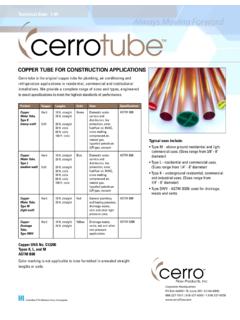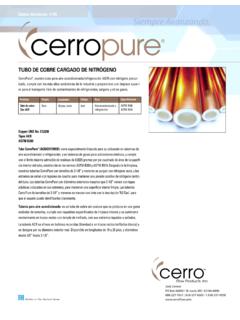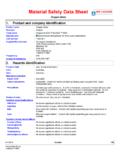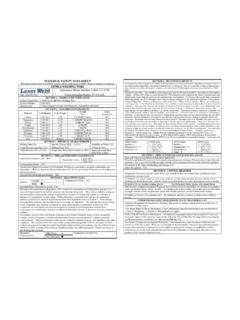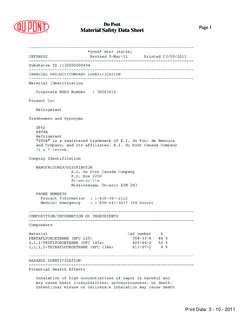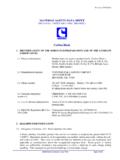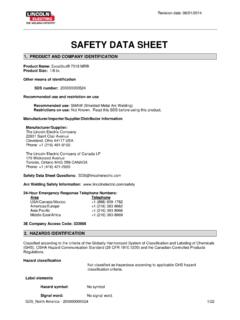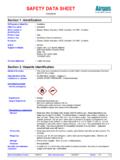Transcription of MATERIAL SAFETY DATA SHEET - Cerro Flow
1 MATERIAL SAFETY data SHEET I. PRODUCT INFORMATION TRADE NAME (COMMON NAME OR SYNONYM) . Copper Tubing (all sizes and wall thicknesses) CHEMICAL NAME FORMULA MOLECULAR WEIGHT . Copper Cu CONTACT PHONE NUMBER ISSUED DATE SUPERCEDES.
2 SAFETY /Environmental 618/337-6000 October 1, 2011 January 12, 2010 II. COMPOSITION/INFORMATION ON INGREDIENTS MATERIAL OR COMPONENT No. WT. % PERMISSIBLE AIR CONC. ( ) . OSHA ACGIH . Copper 7440-50-8 + Dust - Fume - III HAZARDS IDENTIFICATION PRIMARY ROUTES OF ENTRY INGESTION INHALATION SKIN CARCINGENICITY.
3 X Not listed as a carcinogen by NTP, IARC, or OSHA ACUTE OVER EXPOSURE (SYMPTOMS AND EFFECTS) A. Fumes are created by heating metallic copper past its melting point. Proper soldering or sweating copper tubes will not produce fumes. Brazing of copper tube may produce fumes. Consult Copper Development Association, Inc. (CDA) The Copper Tube Handbook for proper joining methods, and recommended solders, fluxes and filler metals (see CDA link on Cerro Flow Products, LLC website to obtain handbook).
4 Use approved ventilation or respiratory protection if the possibility of fumes exists. Inhalation of fume may cause irritation of the respiratory tract or metal fume fever (chills, fever, aching muscles, dry mouth and throat, headache, nausea, vomiting, and diarrhea). Onset may be delayed several hours. B. Ingestion of metallic copper is not a primary route of exposure. Metallic copper may be moderately irritating to the gastrointestinal tract. CHRONIC OVEREXPOSURE (SYMPTOMS AND EFFECTS) No long term effects. Skin irritation or discoloration of the skin and hair are short term.
5 MEDICAL CONDITIONS POSSIBLY AGGRAVATED Wilson s Disease ( an abnormal genetic condition) could be aggravated. IV. FIRST AID MEASURES Inhalation: Remove from exposure; place individual under care of a physician. Ingestion: Induce vomiting in conscious individual and call a physician. Skin or Eyes; Flush with plenty of water. If symptoms develop, consult a physician. V. FIRE FIGHTING MEASURES FLASH POINT AUTO IGNITION TEMPERATURE FLAMMABLE LIMITS IN AIR (% BY VOL.) . Not Applicable Not Applicable Not Applicable FIRE AND EXPLOSION HAZARDS FIRE EXTINGUISHING AGENTS RECOMMENDED FIRE EXTINGUISHING AGENTS TO AVOID.
6 Not Applicable No specific agents recommended No specific agents recommended SPECIAL FIRE FIGHTING PRECAUTIONS . Copper tube will not burn or give off toxic gases in normal fires Use fire fighting methods compatible with surrounding materials. Page 1 of 3 VI. RELEASE MEASURES SPILLS OR LEAKS . Proper installation of copper tubes will not produce dust.
7 Consult Copper Development Association, Inc (CDA) The Copper Tube Handbook for proper joining methods (See CDA link on Cerro Flow Products, LLC website to obtain handbook) Vacuuming is preferred for dust. Do not use compressed air for cleaning. Recycle unused or scrap copper tube at a local scrap metal dealer. VII. HANDLING AND STORAGE NORMAL HANDLING . Avoid conditions which create fumes or fine dust.
8 Use of approved respirators is required where adequate ventilation cannot be provided. Do not use copper tubing where incompatible materials may be present, (see section X). STORAGE . Avoid storage near incompatible materials, see Section X. VIII. EXPOSURE CONTROLS/PERSONAL PROTECTION ENGINEERING CONTROLS .. Local exhaust is recommended for dust and/or fume generating operations where airborne exposure may exceed permissible air concentrations.
9 PERSONAL HYGIENE . Avoid inhalation or ingestion. Practice good housekeeping and personal hygiene procedures. Showering is recommended if significant dust exposure occurs. SPECIAL: PRECAUTIONS/PROCEDURES/LABEL INSTRUCTIONS LABEL SIGNAL WORD: . No special precautions. CAUTION RESPIRATORY PROTECTION.
10 Where airborne exposures may exceed OSHA/ACGIH permissible air concentrations, the minimum respiratory protection recommended is a negative pressure air purifying respirator with cartridges that are NIOSH/MSHA approved against dust, fumes, and mists having a TWA not less than EYES AND FACE . SAFETY glasses recommended when dust or shavings may exist. OTHER CLOTHING AND EQUIPMENT.
